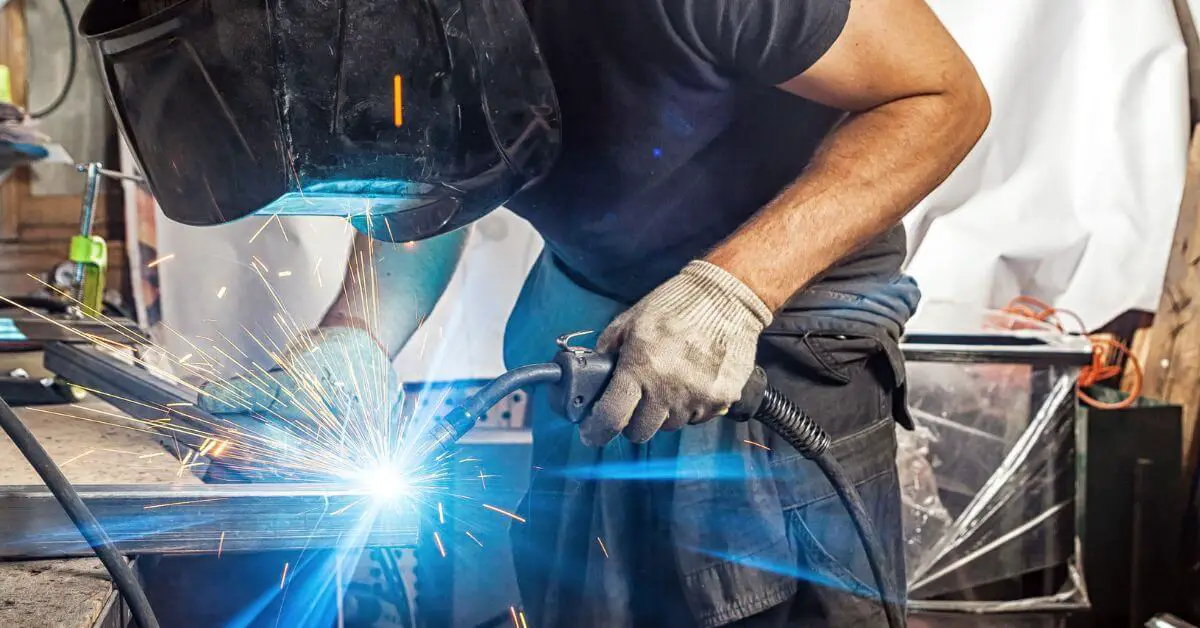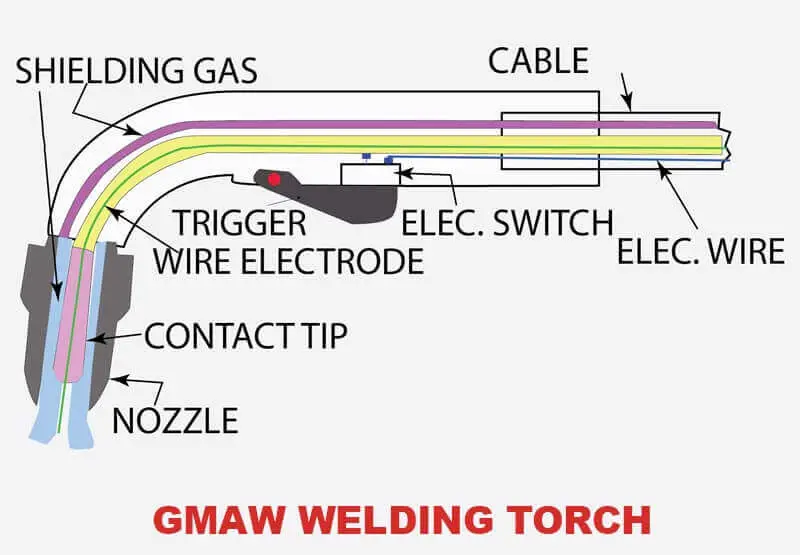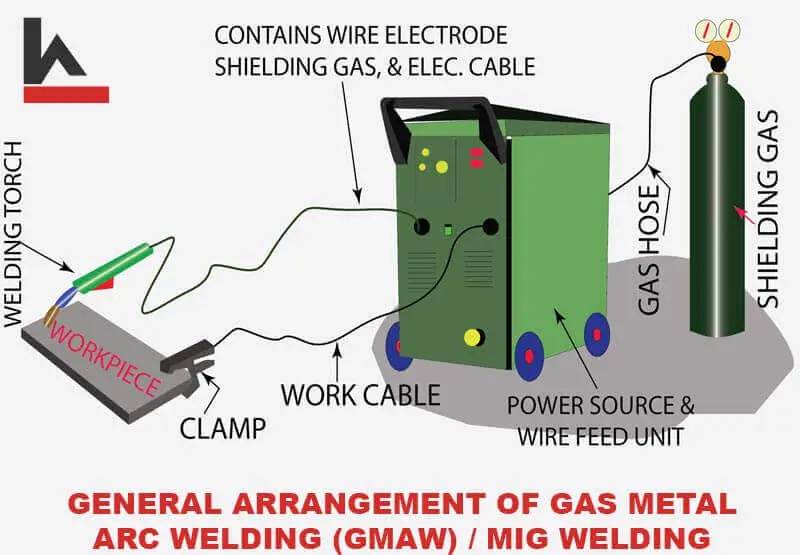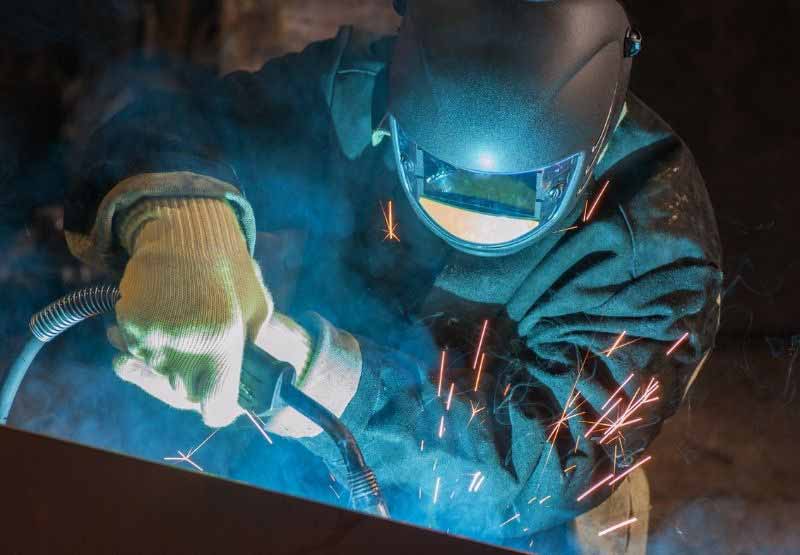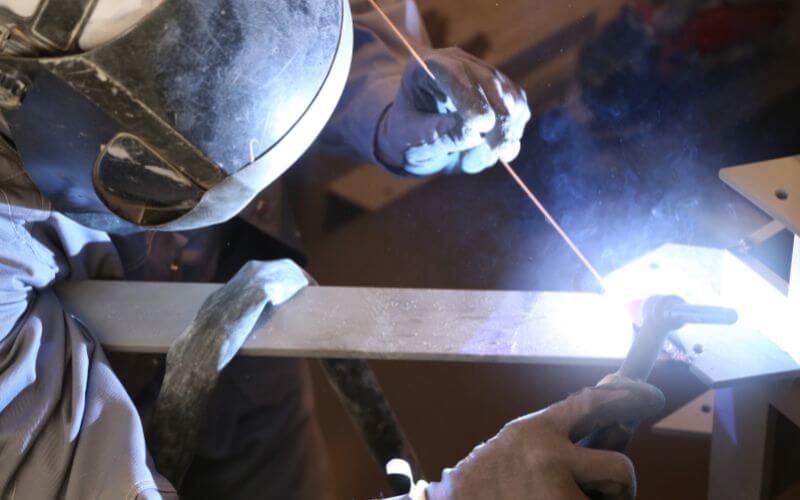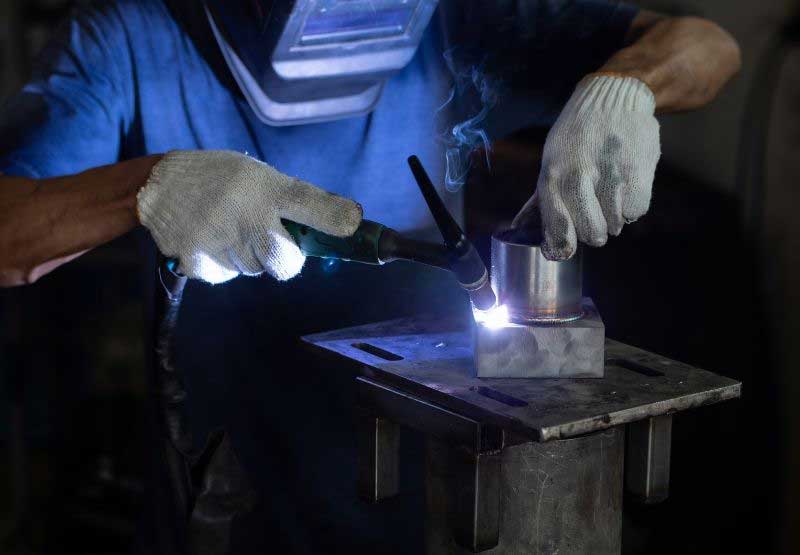MIG and TIG welding are two of the most common welding processes in the engineering industry that have steadily taken center stage in the world of welding. MIG (metal inert gas) and TIG (tungsten inert gas) welding find common ground in using an inert gas. This crucial gas shields the molten weld pool from potential contaminants.
MIG welding takes advantage of a machine-fed consumable solid filler wire. This wire is used to strike an arc and establish a welding pool, creating the structure and strength of the weld. Conversely, TIG welding uses a non-consumable tungsten electrode to strike the arc, while a manually handled filler rod creates the welding pool.
Explore with us the differences that separate MIG from TIG welding while also recognizing their shared similarities.
Brief about MIG and TIG Welding Technique
Before going into the differences between TIG and MIG welding, you must know what MIG welding and TIG welding are.
MIG Welding Process
MIG (metal inert gas) welding is called GMAW (gas metal arc welding). However, MIG is the commonly used name by welders.
MIG is an arc welding process where a machine-fed consumable filler wire is used to strike the arc between the filler wire and the base metal. The filler wire is a bare metal without any flux and is fed through the MIG welding torch’s copper contact tip/nozzle.
The MIG welding torch contains a gas nozzle that surrounds the filler wire and receives the shielding gas from the shielding gas cylinder to protect the weld pool from atmospheric impurities. The filler wire and the shielding gas come out through the MIG welding torch.
The copper tip of the nozzle acts as a conduit for the continuously fed filler wire and conducts the electric current into the filler wire. The filler wire’s diameter and composition vary according to the type of base metals and their thickness.
The current flowing in the filler wire generates sufficient heat to melt the filler wire and the base metals in the welding line to form a molten weld pool, and the shielding gas protects the weld pool from atmospheric impurities.
Once the welding parameters like voltage, filler wire travel speed, inductance, and shielding gas flow are set, the welder has to correctly orient the MIG torch and move it along the welding length and maintain a steady arc. The flow of the filler wire, arc length, and shielding gas flow happens automatically.
It is called semi-automatic welding since the wire movement is automatic, and the welder manually manipulates the MIG torch for the base metal and welding speed. DCEP (direct current electrode positive) or reverse polarity is the normal mode of power used by MIG welding.
MIG welding uses argon or a mix of argon and helium for welding stainless steel. 100% argon is used as the shielding gas for MIG welding aluminum of thickness up to 1/2ʺ and a mixture of argon and helium for MIG welding aluminum thicker than 1/2ʺ.
A mixture of argon and carbon dioxide (75% argon and 25% carbon dioxide) is used for MIG welding ferrous metals, such as mild steel, low and medium carbon steels, etc. Carbon dioxide is called an active gas and helps to improve weld penetration.
You can review our article “Gas Metal Arc Welding (GMAW) | MIG Welding Guide” for more information.
TIG Welding Process
TIG (tungsten inert gas) welding is known as GTAW (gas tungsten arc welding). It is an electric arc welding process that uses a non-consumable tungsten electrode to strike the arc between the electrode and the base metal, a handheld filler rod to create the weld pool, and inert shielding gas to protect the welding arc and the molten weld pool from atmospheric impurities.
The heat generated by the welding arc between the non-consumable tungsten electrode and the base metal is utilized to accomplish the welding. The welder uses a handheld filler rod to add the filler metal into the molten weld pool. The filler rod’s diameter and composition vary with the base metal type and thickness.
The shielding gas used is argon or helium, or a mixture of argon and helium. The welder can directly fuse the base metals without using a filler rod.
TIG welding requires the welder to use both hands (one hand for holding the TIG torch and the other hand to hold the filler rod). This makes it difficult compared to MIG welding. Many TIG welding machines have a foot pedal to control the amperes.
The welder should have a good eye and hand coordination during TIG welding, which can come only through practice. As TIG welding gives more control to the welder on the welding process (compared to other welding processes) and enables the welder to produce excellent-looking strong weld beads.
TIG welding can work with DC (direct current) and AC (alternating current). TIG welding can work at low current (low heat generation) and produce weld joints with low heat-affected zone.
You can review our article “What is TIG Welding or Gas Tungsten Arc Welding (GTAW)?” for more information.
Similarities Between TIG and MIG Welding Methods
Arc-based Welding
MIG and TIG welding both use an electric arc to create a weld. The arc generates intense heat that melts the base metal and the filler material, allowing them to fuse.
Shielding Gas
MIG and TIG processes use shielding gas to protect the weld area from atmospheric contamination. The shielding gas, typically argon or a mixture of argon and helium, creates a protective atmosphere around the weld, preventing oxidation and other issues that could weaken the weld.
Precise Control
TIG and MIG welding offers the advantage of precise control over the weld. This control level allows for creating high-quality welds with minimal defects and improved visual appearance.
Versatility
TIG and MIG welding can be used to weld various materials, including non-ferrous metals like aluminum, stainless steel, and some alloys. This versatility makes these processes suitable for various automotive, aerospace, and fabrication applications.
Efficiency
TIG and MIG welding are both relatively efficient processes. They have high deposition rates, meaning welds can be made quickly, increasing productivity.
MIG vs TIG Welding – Key Differences between MIG and TIG Welding
Before you decide which welding technique to choose, look at the pros and cons of using TIG and MIG welding for your project.
Welding Process
MIG Welding:
- MIG is an arc welding process where a machine-fed consumable filler wire is used to strike the arc between the filler wire and the base metal and to create a molten weld pool. The filler wire is fed through the MIG torch’s copper contact tip/nozzle.
- The copper tip acts as a conduit for the continuously fed filler wire and conducts the electric current into the filler wire. Since the filler wire is fed continuously, the welder can weld without interruption.
TIG Welding:
- TIG is an arc welding process that uses a non-consumable tungsten electrode to strike the arc between the electrode and the base metal, a handheld filler rod to create the weld pool, and inert shielding gas to protect the welding arc and the molten weld pool from atmospheric impurities.
- TIG welding must be interrupted when one consumable filler rod is consumed, and the next filler rod is to be taken manually.
Welding Torch
MIG Welding:
- The MIG welding torch has a contact tip through which the filler wire comes out, a control switch, and a nozzle surrounding the filler wire for shielding gas flow.
- The MIG torch is connected to the MIG machine by a cable and to the shielding gas cylinder by a hose.
- When you take the MIG torch near the welding line and press its control switch (trigger), the flow of filler wire, the flow of current into the wire, and the shielding gas start simultaneously, and the arc is struck.
- The MIG torch may have provision for cooling by compressed air or water.
TIG Welding:
- The TIG welding torch has a collet to hold the tungsten electrode and a nozzle surrounding the collet for shielding gas flow.
- The TIG torch is connected to the TIG power source through a cable and to the shielding gas cylinder through a hose.
- You can take the tungsten electrode tip near the welding line, start the shielding gas knob and start the arc by pressing the button on the torch or the foot control switch and start the welding.
- Depending on your TIG machine, the arc starting method can be a scratch start, lift start, or HF (high frequency) start.
- The TIG torch can have provision for cooling by compressed air or water. A water-cooled TIG torch can be used for higher welding current, but the torch is comparatively heavy.
Shielding Gas
The function of the shielding gas in MIG and TIG is to protect the welding arc and the molten weld puddle from atmospheric air and contaminants. In the absence of the shielding gas, the oxygen in the air can react with the weld metal, and the contaminants can enter the weld pool.
MIG Welding:
- Uses argon or a mix of argon and helium for welding stainless steel.
- 100% argon is used as the shielding gas for MIG welding aluminum of thickness up to 1/2ʺ and a mixture of argon and helium for MIG welding aluminum thicker than 1/2ʺ.
- A mixture of argon and carbon dioxide (75% argon and 25% carbon dioxide) is used for MIG welding ferrous metals, such as mild steel, low and medium carbon steels, etc.
- MIG welding uses a much higher flow rate (cubic feet per hour) of shielding gas than TIG welding.
TIG Welding:
- TIG welding normally uses inert gasses for shielding, and it can be 100% argon or 100% helium or a mix of argon and helium.
- The tungsten electrode is sensitive to carbon dioxide and oxygen. Hence, a mix of inert and active gases like carbon dioxide or oxygen cannot be used for TIG welding.
How the Welder Starts the Welding
MIG Welding:
- The welder sets the voltage, wire travel speed, shielding gas flow, and inductance.
- The welder strikes the arc between the filler wire and the base metal by moving the filler wire tip nearer to the base metal and pressing the trigger of the MIG torch.
- The current flows into the filler wire, an arc is struck, the shielding gas starts to flow, and the welder moves the torch to create the weld pool.
- The current flowing in the filler wire generates sufficient heat to melt the filler wire and the base metals in the welding line to form a molten weld pool.
TIG Welding:
- The welder sets the ampere and the flow of shielding gas.
- The welder moves the tungsten electrode tip nearer to the welding surface, starts the flow of shielding gas, starts the arc.
- And moves the TIG torch along the welding line in one hand and uses the filler rod in the other hand to add the filler metal to the weld pool.
- Putting the current on or off and varying the current is done using the foot switch (foot pedal).
- TIG welding produces strong tacks, and it is good for root welding.
Weld Bead Visual Appearance
MIG Welding:
- A good MIG welder can produce a strong weld bead with more strength than its base metal.
- MIG welded beads do not look as good or as visually appealing as a TIG weld bead.
TIG Welding:
- The weld bead created by a skilled TIG welder is narrow, strong, defect-free, has good penetration, and is pleasing to the eyes.
- Quality TIG weld beads do not have spatters; cleaning by wire brush or slight polishing makes them look bright.
- TIG welder follows a consistent weave pattern which has a visually appealing effect. The weld beads of stainless steel and aluminum parts can be retained as it is after cleaning, and they look excellent.
Welding Speed
MIG Welding:
Has better welding speed compared to TIG welding, and the reasons are:
- It has the advantage of automatic filler wire feed, and the welder can keep up a faster welding speed.
- Since the filler wire is fed continuously, the welder need not interrupt the welding.
TIG Welding:
Is slower than MIG welding, and the reasons are:
- TIG welders use both hands (one hand for holding the TIG torch and the other for holding the filler rod) and do the welding manually. The process becomes slow.
- The TIG welder uses a filler rod of fixed length, and once this rod is consumed, the welder has to interrupt to take a new filler rod. This also makes TIG welding a slow process.
Electric Power (Polarity)
MIG Welding:
- MIG welding normally works on DCEP (direct current electrode positive [reverse polarity]).
TIG Welding:
- TIG welding can work with AC and DC, and many TIG welding machines have a switch to change over from AC to DC or vice-versa. TIG with AC works better for aluminum welding.
- TIG welding is normally used with AC or DCEN to increase the life of the tungsten electrode.
Tungsten Inclusion
MIG Welding:
- MIG welding does not use tungsten electrodes.
TIG Welding:
- TIG welding faces the issue of tungsten inclusion (a weld defect) when tungsten particles get mixed in the molten weld pool.
Autogenous Welding
Autogenous welding is a unique fusion welding method that does not require the application of any external filler material. During this process, the weld is created by melting the base material of the two objects being joined.
A bond is formed by raising the temperature of the metal to the point of melting and then applying pressure. This welding technique can be used across various joint types and on numerous materials.
MIG Welding:
- Not possible with MIG.
TIG Welding:
- TIG welding can be executed in autogenous welding mode (the heat produced by the tungsten electrode is used to fuse the base metals without a filler metal).
Cost
MIG Welding:
Is more economical than TIG because:
- A MIG machine costs less than a TIG machine.
- The continuous and automatic filler wire feed makes MIG welding much faster than TIG welding (less welding cost per foot of weld bead).
- MIG welders create more weld length per unit of time than TIG welders.
- MIG welders charge less than TIG welders (since a welder with less experience can do MIG welding).
TIG Welding:
Is costlier than MIG because:
- The initial cost of a TIG machine is more than MIG welding equipment.
- TIG welding is a slow process, and with a low weld metal deposition rate, the cost incurred per foot is high.
- TIG welders charge more than MIG welders (due to their experience and skill).
- TIG welding needs a tungsten electrode, which contributes to the increased cost of welding (even though we call the tungsten electrode non-consumable, a small portion is consumed for every foot of weld length).
Ease to Learn
MIG Welding:
Is easier to learn compared to TIG welding because:
- MIG welders with lesser experience can lay good beads on a project with the easier-to-learn MIG process.
- Once the MIG machine is set for welding (voltage, wire travel speed, and shielding gas flow), the welder has to manipulate the MIG torch to create a good weld, and the wire feed is automatic.
- You have the choice of using one hand or both hands to manipulate the MIG torch. For this reason, many welding profession aspirants find MIG welding easy to learn.
- MIG welding is better at handling thick base metals than TIG welding. Hence, a MIG welder can get wide experience welding different metals.
TIG Welding:
Is harder to learn than MIG Welding because:
- In TIG welding, the welder has to use both hands. One hand for manipulating the TIG torch and the other for holding and feeding the filler rod.
- Their eyes should concentrate and coordinate the activities to create a good TIG weld bead.
- Further, the TIG welder has to control the ampere using a foot pedal.
- TIG welder can acquire and improve their skill only by repeated practicing, which takes time.
Because of the above, TIG is a complex process that takes a long time to learn.
When to use TIG and MIG Welding
MIG Welding:
- It is advantageous for out-of-position welding since the welder has one hand free to hold the base metals or to balance them.
- When welding mild steel and alloy steels, use MIG since it is more productive, and normally the parts are painted.
- MIG is a good option for thicker base metals.
- MIG welding manufactures railway coaches and light, medium, and heavy metal fabrications.
- MIG welding is used in the automobile and aerospace industry.
TIG Welding:
- TIG welding is good for welding thin-section base metals vulnerable to warp and burn-through.
- TIG welding is good for critical and artistic jobs.
- TIG is the option if you want an aesthetically good-looking weld bead.
- It is preferred for welding stainless steel, aluminum, nickel, nickel alloys, copper, etc.
- Food processing industries, dairy industries, chemical industries, and pharmaceutical industries need huge containers, tanks, and equipment made from stainless steel sheets. The TIG process is the best welding process for these items.
- TIG welding is used in the aerospace industry.
Welding Stainless steel
Stainless steel has low thermal conductivity, meaning it retains the heat in the welding zone for more time. Due to this property, stainless steel can warp at high temperatures and distort as it cools.
MIG Welding:
- MIG welding has high productivity, so MIG welding with pulsed current is preferred for stainless steel welding, specifically for out-of-position welding and thin sections (less than 1/4ʺ).
- The pulsing current keeps the average current low (hence moderate heat).
- The spray transfer method is preferred for MIG welding stainless steel of sections 1/4ʺ and above.
- The shielding gas used is argon or helium, or a mixture of argon and helium.
TIG Welding:
- TIG welding gives more control to the welder, and they can adjust the heat to suit the thickness of base metals and avoid excess heat and warp.
- The tight and focused arc of TIG welding makes it suitable for welding stainless steel.
- Another reason for preference TIG welding for stainless steel is its excellent-looking weld beads since stainless steel parts are seldom painted.
- TIG welding is normally preferred for welding thinner section base metals. And using a pulse TIG welding method gives more control to the welder (to control the amperes/heat).
Welding Aluminum
Unlike stainless steel, aluminum has high thermal conductivity. And it develops a layer of aluminum oxide as soon as it is exposed to atmospheric air (aluminum reacts with the oxygen contained in the air to form aluminum oxide). The layer of aluminum oxide disrupts the welding arc.
The welding surfaces of the aluminum base metals should be thoroughly cleaned before MIG/TIG welding.
MIG Welding:
- The aluminum filler wire should be clean and free from any contamination.
- The soft aluminum filler wire can pose a problem in feeding. And this problem can be eliminated by using a welding gun equipped with an aluminum spool (called a spool gun).
- DCEP polarity is good for welding aluminum since it cleans the oxide layer on the welding surface. Use spray transfer or pulsed spray method.
- MIG welding of aluminum less than 2 mm (14 gauge) is not preferred.
- The shielding gas should be argon or a mix of argon and helium.
TIG Welding:
- TIG welder has the advantage of precise heat control (using the foot pedal), which is an advantage for welding aluminum.
- The ability of the TIG to work on alternating current (AC) helps to overcome the aluminum oxide layer on the aluminum. This makes TIG welding a better choice for welding aluminum.
- TIG welding is preferred for welding thin sections of aluminum.
- Aluminum welded parts are normally not painted. And this is another reason for preferring TIG welding aluminum since it produces excellent-looking weld beads.
Conclusion
We cannot say that one method, MIG or TIG, is better than the other. Because both welding techniques have distinct pros and cons. Instead, they’re designed for optimal results in their respective niches.
As you start on future welding projects using MIG and TIG techniques, keep in mind their strengths and unique applications. Utilizing the benefits of each process, you can achieve the perfect combination of efficiency, quality, and durability that will stand through time.
References:

